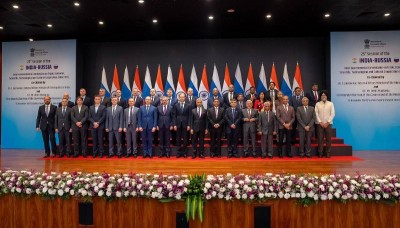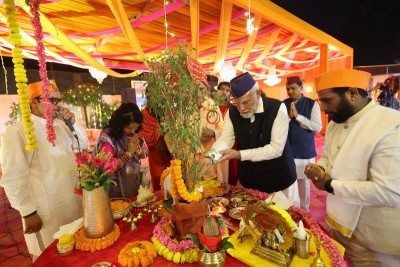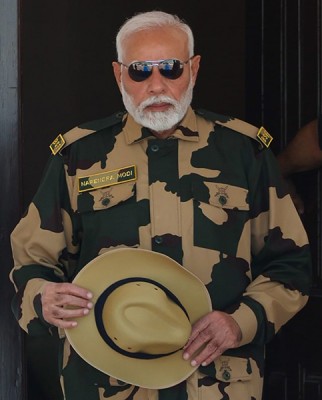
Jharkhand: Visible Improvement
On January 4, 2019, the Security Forces (SFs) killed an ‘area commander’ of the Communist Party of India-Maoist (CPI-Maoist), identified as Chander Singh Bhokta aka Ganju, in an encounter in the Kurkheta forest area under Zori-Hunterganj Police Station limits in the Chatra District of Jharkhand. Ganju, a native of Birlutudag village under the Rajgir Police Station of the District, was operating in the Koleshwari zone along the Jharkhand-Bihar border. SFs recovered one INSAS (Indian Small Arms System) assault rifle from the encounter spot.
No other Left Wing Extremism (LWE)-linked fatality has been recorded in the State in the current year, thus far (data till January 6, 2019).
According to partial data compiled by the South Asia Terrorism Portal (SATP), at least 53 fatalities, including 17 civilians, 10 SF personnel and 26 Naxalites (Left Wing Extremists), were recorded in Jharkhand in LWE-linked violence in 2018, as against 56 fatalities, including 29 civilians, two SF personnel and 25 Naxalites, in 2017. This is the lowest number of overall fatalities recorded in the state since the formation of the CPI-Maoist on September 21, 2004. A previous low of 56 was recorded in 2017. Overall fatalities in the State have been declining since 2014, barring 2016.
More importantly, fatalities among civilians in 2018 decreased by 41.37 per cent, as compared to 2017, from 29 to 17. Civilian fatalities through 2018 at 17, have been the lowest number of such fatalities recorded in the State during the course of a year since the formation of the CPI-Maoist. The previous lowest of 18 fatalities was recorded way back in 2006. A peak of 79 fatalities in this category was recorded in 2011.
Further, at least 13 incidents of arson carried out against civilian construction companies were registered in 2018, as against 26 such incidents in 2017.
Indeed, according to a December 17, 2018, report, Jharkhand Director General of Police (DGP), D.K. Pandey claimed that “eighty percent of extremism here has been contained, curbed and finished”.
There are, however, some persisting threats.
Worryingly, fatalities among SFs witnessed a sharp increase, from two (in one incident) in 2017 to 10 (in three separate incidents) in 2018, a five-fold spurt. In a major incident, on June 26, 2018, seven Jharkhand Jaguars (JJ, an anti-Maoist special operations group) personnel were killed and four were injured in an attack by Maoists in the Chinjo area under Bargarh Police Station limits of Garhwa District. Deputy Inspector General (DIG) of Police Vipul Shukla disclosed that a joint team of SFs from the Central Reserve Police Force (CRPF), Jharkhand Jaguars, and the local Police were marching towards a rebel hideout after receiving information about the presence of some Maoists in the area. The Maoists triggered a landmine blast and simultaneously opened fire on the SF personnel, killing seven. The last major incident (three or more killings) targeting SFs in the State occurred on January 27, 2016, when seven Policemen were killed and eight were injured in a landmine blast by the CPI-Maoist in the Chattarpur Block in Palamu District. The SF personnel were going towards the Kalapahari area in a convoy when their vehicle came under attack.
SFs killed 25 Naxalites in 2018: 13 CPI-Maoist cadres, five Tritiya Prastuti Committee (TPC) cadres, four of the Peoples' Liberation Front of India (PLFI), and three of the Jharkhand Jan Mukti Parishad (JJMP). One JJMP cadre was lynched by villagers. On November 29, 2018, Anil Singh, belonging to JJMP and a close relative of JJMP ‘chief’ Pappu Lohra, was lynched for allegedly attempting to rape a woman in Irmu village in Palamu District. Interestingly, no incident of internecine clashes was reported in 2018. In 2017, SFs had eliminated 14 Naxalites: nine PLFI cadres, four CPI-Maoist cadres, and one TPC cadre. Another 11 Naxalites were killed in internecine clashes: 10 TPC cadres and one CPI-Maoist cadre. However, in both these years, the kill ratio favoured the SFs – 1:2.5 in 2018 and 1:7 in 2017. The overall kill ratio between September 21, 2004 and January 6, 2019 also favoured the SFs, at 1:1.7.
Meanwhile, at least 185 LWEs were arrested in 2018 in addition to 222 such arrests in 2017. At least 233 Maoists were arrested in 2016 and 157 in 2015. Mounting SF pressure also resulted in the surrender of 22 Maoists in 2018, in addition to 42 such surrenders in 2017. There were 35 surrenders in 2016 and 12 in 2015.
The number of Districts from where killings were reported increased in 2018, as compared to 2017. Out of a total of 24 Districts in Jharkhand, fatalities were reported from 13 in 2018: Latehar (11); Palamu (nine); Garwah (seven); Hazaribagh (five); Ranchi and Seraikela-Kharsawan (four each); Giridih and Khunti (three each); Simdega and West Singhbhum (two each), and Chatra, East Singhbhum and Gumla (one each). 12 Districts recorded such fatalities in 2017 – Khunti (nine); Hazaribagh and Palamu (seven each); Chatra and Giridih (six each); Gumla and Simdega (five each); West Singhbhum (four); Latehar (three); Bokaro (two); and East Singhbhum and Ramgarh (one each).
Significantly, on April 16, 2018, the Ministry of Home Affairs (MHA) disclosed that there were it categorised at least 30 Districts as ‘worst Maoist-affected’, across seven States. The maximum of 13 of these Districts fell in Jharkhand: Bokaro, Chatra, Garhwa, Giridih, Gumla, Hazaribagh, Khunti, Latehar, Lohardaga, Palamu, Ranchi, Simdega West, and West Singhbhum. On April 16, 2018, MHA had also disclosed that the number of Maoist-affected Districts covered under the Security Related Expenditure Scheme (SRE) scheme had decreased from 126 in 10 states to 90 in 11 states. 19 of these 90 districts were in Jharkhand. In addition to the 13 worst-affected districts mentioned above, the other six Districts included Dhanbad, Dumka, East Singhbhum, Koderma, Ramgarh, and Saraikela-Kharaswan.
According to SATP data for 2018, based on assessments of underground and over-ground activities of the Naxalites, Hazaribagh, Latehar, Palamu, and Ranchi Districts remained highly-affected; Chatra, East Singhbhum, Garwah, Giridih, Gumla, Khunti, Seraikela-Kharsawan, and West Singhbhum were moderately affected; while Bokaro, Dhanbad, Dumka, Lohardaga, Pakur and Ramgarh, remained marginally affected.
According to a December 17, 2018, media report, State DGP D.K. Pandey also disclosed that some Maoists were making all-out efforts to sneak into Jharkhand from the Bihar and Odisha sides of the State’s borders. Citing an incident of arson which took place in Chatra District in December 2018 (date not mentioned), where four vehicles of the National Thermal Power Corporation (NTPC) were put on fire by the Maoists, the DGP asserted that this incident had been orchestrated by a group led by the Bihar-based Maoist Karu Yadav. Top Maoists leaders, the DGP added, had pushed Yadav to create a disturbance in Jharkhand. However, he asserted, the “days are not far off when they will be neutralised completely”.
Meanwhile, apart from measures taken earlier, the State Government has launched several initiatives through 2018. According to a December 5, 2018, report, Jharkhand had identified another 20 top CPI-Maoist cadres. According to an unnamed Police source involved in anti-Naxal operations, “The names of the 20 Maoists have been sent to the State Home Department for approval, after which they will be made public.” The names included one of Prayag Manjhi, who had a reward of INR 10 million on his head. Manjhi is a CPI-Maoist ‘central committee’ (CC) member. The Police also initiated processes to seize the properties of these 20 Maoist leaders. Earlier, the State Government had approved a list of 210 Maoists. The State Government announces reward amounts to get information about the Maoists, leading to their arrest.
On June 15, 2018, the Jharkhand Police launched a ‘pamphlet war’ against the CPI-Maoist, under which 16,000 posters were put up in the five worst Naxal affected Districts identified as Garhwa, Palamu, Latehar, Lohardaga, and Gumla. The posters had information about 12 most wanted Maoists and the bounties on their heads, with an assurance that the name and identity of informants would be kept secret. The drive was launched under psychological operations to mount all-round pressure on the Maoists. Police dropped the 16,000 pamphlets in a day from helicopters in the interiors of the five target Districts. The cadres mentioned in the pamphlets were CPI-Maoist ‘politburo member’ Sudhakaran of Telangana, carrying an award of INR 10 million on his head; his wife Nilima (INR 2.5 million); Bhwani aka Sujata (INR 1 million) of Andhra Pradesh; Ravindra Ganjhu (INR 1 million) of Latehar; Birsai aka Saketh Singh aka Umesh Ganjhu (INR 1 million) of Latehar; Balram (INR 1 million) of Latehar; Buddheshwar Oraon (INR 1.5 million) of Latehar; Chandrabhushan Yadav (INR 1 million) of Latehar; Chhotu Singh Kherwar (INR 1.5 million) of Latehar; Mrityunjay Bhuiyan (INR 1 million) of Chatra; Sarvjit Yadav (INR 1.5 million) of Chatra; and Umesh Yadav (INR 2.5 million) from Jehanabad in Bihar. None of them have been arrested thus far.
Meanwhile, according to the latest data provided by the Bureau of Police Research and Development (BPR&D), the State had a police-population ratio (policemen per hundred thousand population), as on January 1, 2017, of 174.96, significantly lower than the sanctioned strength of 229.19, though much higher than the national average of 150.75. The ratio was 167.92 per 100,000 on January 1, 2016. On January 1, 2005, the police-population ratio of the State was 160.5, again, much higher than the national average of 140.4.
The LWE menace in Jharkhand is increasingly being brought under control, and there is visible improvement in the ground situation. Nevertheless, several challenges remain to be addressed, and both the State and Central Governments will need to shore up their efforts to bring the remaining affected areas to normalcy.
Support Our Journalism
We cannot do without you.. your contribution supports unbiased journalism
IBNS is not driven by any ism- not wokeism, not racism, not skewed secularism, not hyper right-wing or left liberal ideals, nor by any hardline religious beliefs or hyper nationalism. We want to serve you good old objective news, as they are. We do not judge or preach. We let people decide for themselves. We only try to present factual and well-sourced news.







